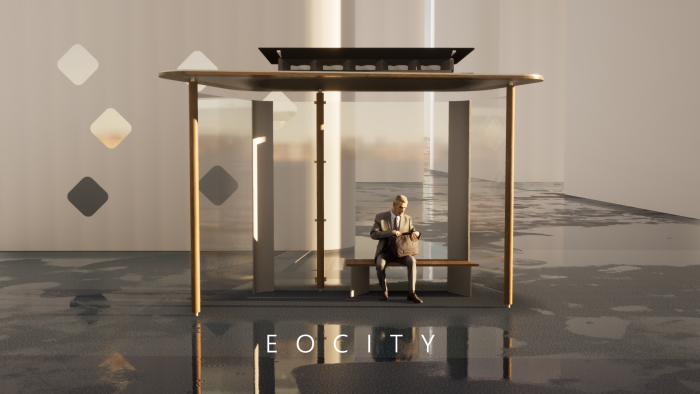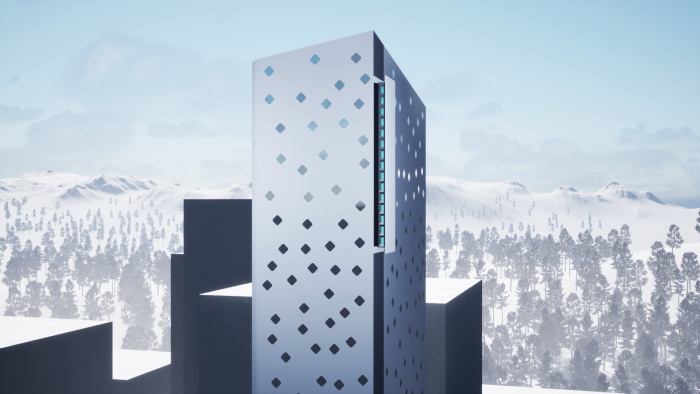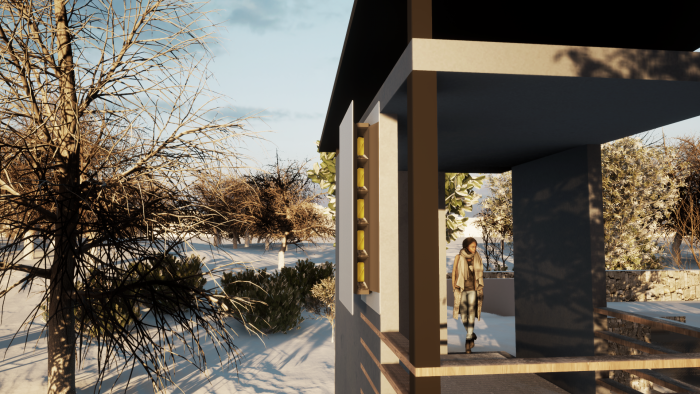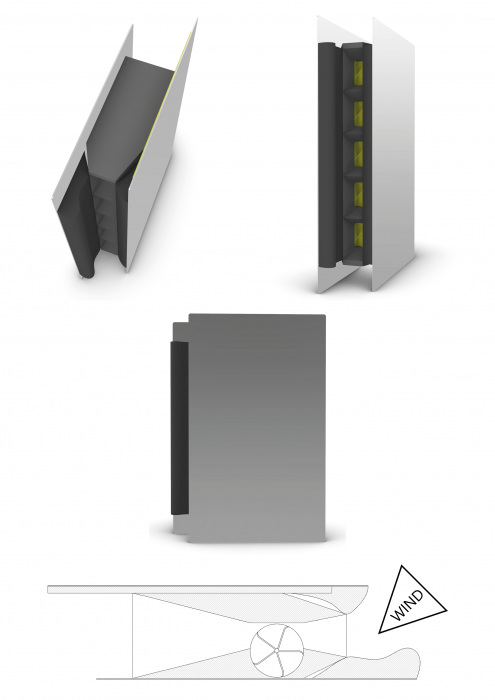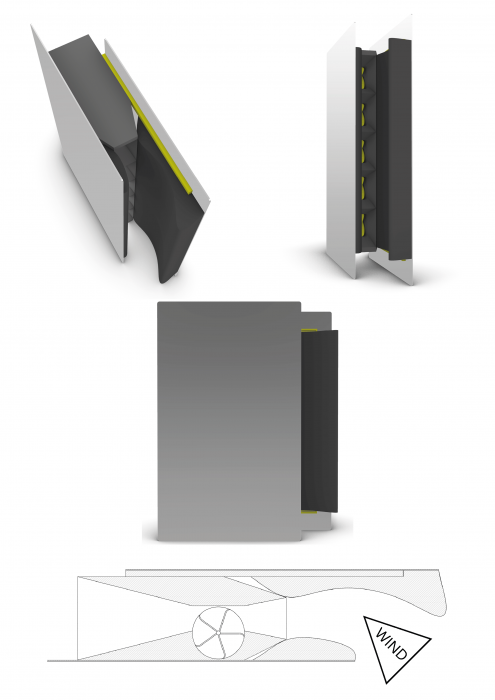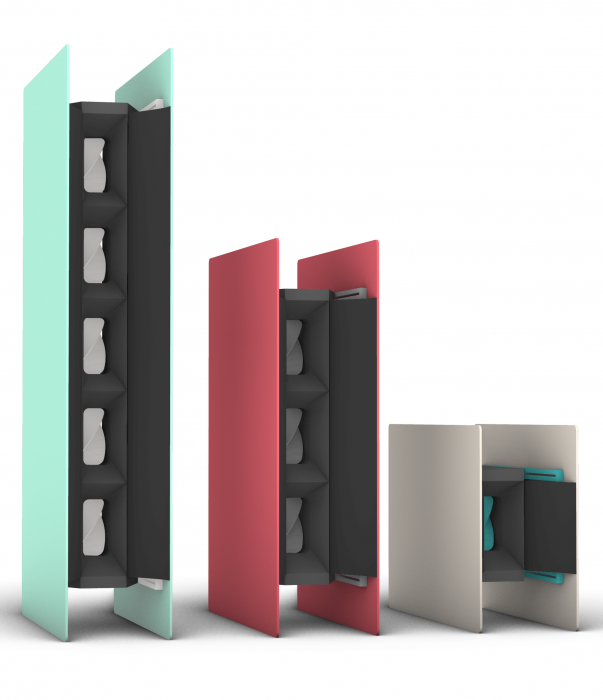Eocity brings populated areas and wind turbines together. All while preserving our countryside, it integrates into the urban and rural areas to provide a source of energy which is clean, aesthetic and affordable.
This project is a conduit for the democratisation of green energy production. It’s also perfect for companies as well as private individuals (well-off or not), both in megacities and isolated hamlets.
Eocity is a modular wall-mounted wind turbine with variable geometry air flow concentration device.
This project consists of two panels between which you have a series of boxes, each containing a wind tunnel, a turbine and the systems enabling the conversion of their rotation into electrical energy. The wind turbine is modular by design. It’s therefore possible to vary the number of boxes and the size of the panels to have different overall dimensions. It can also be equipped with grating preventing birds and insects from coming into contact with the turbines.
One of the panels is affixed to the wall of a building, for example, so it’s immobile. The boxes are attached to this first panel.
The second panel is affixed to the boxes via motorised runners. Thanks to these, the panel will change position to adapt to the wind direction. This way, the device does not need to be rotated to be correctly oriented to the wind.
Each panel is equipped with an air deflector, positioned in front of the box entrance. This deflector has a variable geometry, and enables the air flow to be driven precisely towards the turbines depending on the orientation of the wind, in coordination with the movements of the second panel.
The air deflector is made of a flexible membrane, under which a series of cushions are placed which rise independently to modify the curve and therefore the aerodynamic properties of the unit.
The control module (and its batteries) enabling the automation of the set’s functions is contained in the series of boxes. It’s connected to a wind analysis module, external to the wind turbine, comprised of a weather vane and sensors interpreting its position.
(Patent application filed)
Please highlight how the concept/idea can be exemplary in this context
The project is designed to promote ecological and social transition for everyone, through an adjustable renewable energy producing device in order to provide daily energy needs.
Furthermore the very design of the project guarantees its durability. It will consist of, for the construction of the wind turbine, assembling the boxes containing the turbines, and then adding the panels. Consequently, the device is adaptable to a multitude of scenarios, and each element is replaceable; the boxes themselves can be taken down to change the different elements. The wind turbine therefore has a theoretically limitless lifespan and can be upgraded in order to be optimised as technological innovations occur rather than being replaced and thrown away.
Strict attention will also be paid to the choice of materials (recycled metals and plastics, bioplastics, etc.) and to their use (topology optimisation).
Please highlight how the concept/idea can be exemplary in this context
The wind turbine’s mobile panel, located on the outside of the device, is the most visible element of the set and offers a large surface area which may be treated in multiple ways. It could be covered with different materials and colours, including different patterns to blend into the environment in which the wind turbine will be installed as much as possible. It would also be possible, for example, to cover the panel with plant life.
The general aesthetic is voluntarily minimalistic, because this wind turbine has been conceived to be integrated into the city, to be placed as plainly as possible on the building without altering it.
In terms of use, this project has the potential to correct a problem specific to the wind turbine: sound pollution. The fact that the blades are placed inside the aerodynamic tunnels enables the reduction of the noise produced.
Please highlight how the concept/idea can be exemplary in this context
The objectives in terms of inclusion will be achieved, among other things, thanks to the controlled choice and use of materials in order to lower the cost of the wind turbine as much as possible.
The modularity also offers the option of configuring the most modest products in terms of dimensions and technologies, which are accessible to everyone.
As inclusion also involves culture, the adaptability of the wind turbine’s aesthetics also meets this objective. Being able to personalise the wind turbine enables their integration in regions which are very different from each other, their adaptation to all cultures, and therefore counters the standardisation inherent to mass production.
Please highlight how this approach can be exemplary
The three dimensions (aesthetics, environmental sustainability, inclusion) combine naturally and in an exemplary way in this project which is at the same time a cultural, social and energy project, discreet and adaptable from an aesthetic point of view to any urban and rural environment. Modular and of human dimension, this project is within everyone's reach in terms of installation, price and aesthetics, and allows everyone to produce renewable energy in an ultra-local way. The project is therefore exemplary in its modularity and the fact that it is open to all.
Eocity is an innovative project through its capacity to bring together aesthetics and energy production on the one hand, but also through the way in which the energy itself is produced. Through its design which enables the concentration of air flow on smaller turbines, without the need to rotate the unit to face the wind, this project breaks away from the numerous problems linked to classic wind turbines such as the space required for their functioning, noise pollution, their elevated cost, production being halted in the event of strong winds due to the blade sizes, etc.
If solar panels today enable a horizontal use of inhabited areas in order to produce green energy, the concept of Eocity gives the option of using their verticality, and could, in the long term, contribute to reducing the impact of classic wind turbines on our natural landscapes.
This project also innovates through its target audience. It is indeed intended for all types of infrastructures, to individuals from all social backgrounds and it can integrate into all areas, inside and outside of Europe.
This project fulfils objectives which fall under ecological transition, aesthetics, urban planning and inclusion. I would like to request funding from the government and local authorities likely to fund the Eocity development. The long term funding system could go through financial aid granted by the public sector to wind turbine purchasers, based on the model of financial aid granted to individuals for the installation of solar panels.
The following year (2022/2023) will be dedicated to the prototyping of the project, aerodynamic studies and resistance calculations, then to the first steps towards production, financing (search for partners) and the marketing of the wind turbine. Regarding these last points which fall under the project’s administrative and financial construction, I can rely on contact persons I know who can guide me in this development.
@Maure, 2022
Content licensed to the European Union.
